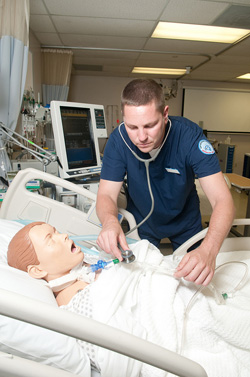Pretend Patients Offer Real Life Drama

Respiratory Care student Jeff Tibbetts works on Sim Man
In addition to the birthing mom and mature man, there are also infant and adolescent mannequins for a total of nine simulators according to Nancy Harnois, NECC’s technical lab coordinator. All are controlled wirelessly by the instructor who sits removed from the pretend patients and health care students. This forces the students to use their own skills and think, sometimes quickly, without turning to the instructor for immediate assistance.
The mannequins, which come with a variety of preprogrammed simulations, can also be programmed by the instructors for a “running simulation on the fly,” says Harnois. They can be programmed, depending upon the mannequin, to cry, sweat, breath, talk, have pulses, feel pain, provide urinary output, and suffer peripheral cyanosis (the hands and feet turn blue). As students progress through their programs, the simulations become more difficult.
Thanks to these high-tech, state-of-the-art mannequins, NECC is graduating confident students well prepared to sit for their national boards, Harnois says. Students work on mannequins that look and feel like real patients, she notes.
“These simulators can blink. Their pupils dilate when you shine a light on them. This helps us create a situation that is as close to real life as possible,” she says. “Students can listen to the lungs and even hear crackles and wheezing.”
While nursing, respiratory care, and paramedic students are the primary users of the
mannequins, eventually all health care students will have some exposure to them.
The Sim Family will move to the new Dr. Ibrahim El-Hefni Allied Health and Technology Building on Common Street when construction is complete in the fall of 2013 with the possibility of expanding the Sim Family by a few members.
“Everyone is respectful of these mannequins,” says Harnois. “Faculty, staff, and students treat them as people and not as dummies. The difference between the health care students of 1990 and 2012 is that today they are working on simulators who like and can act like humans.”







